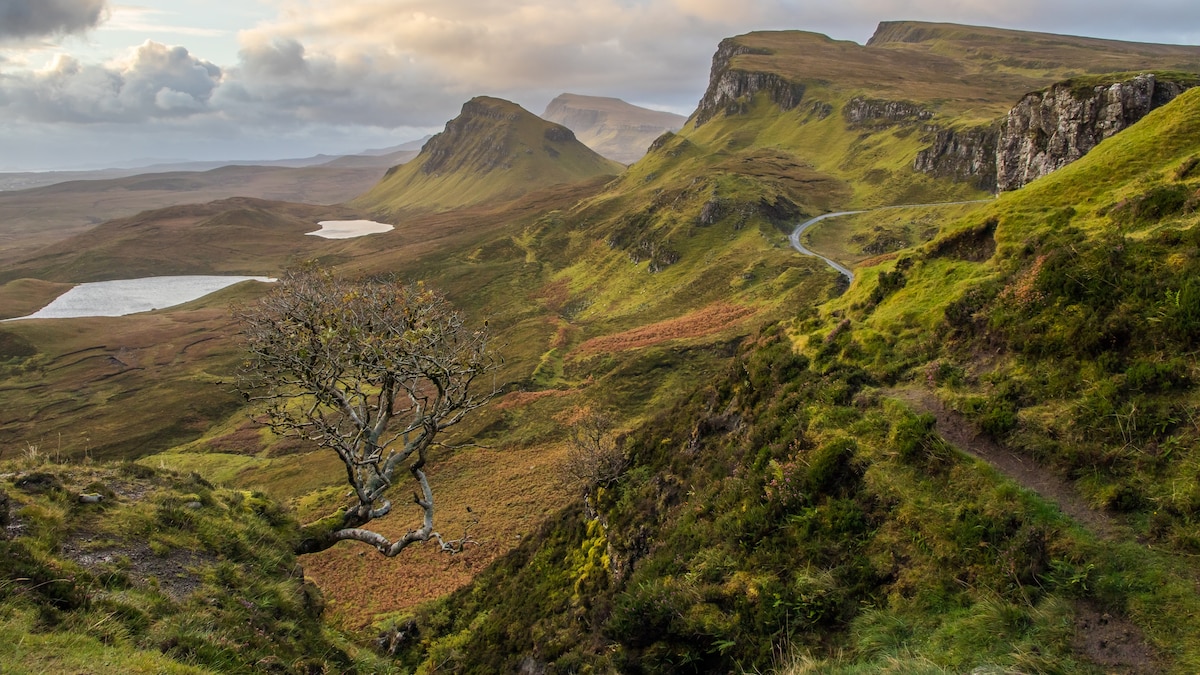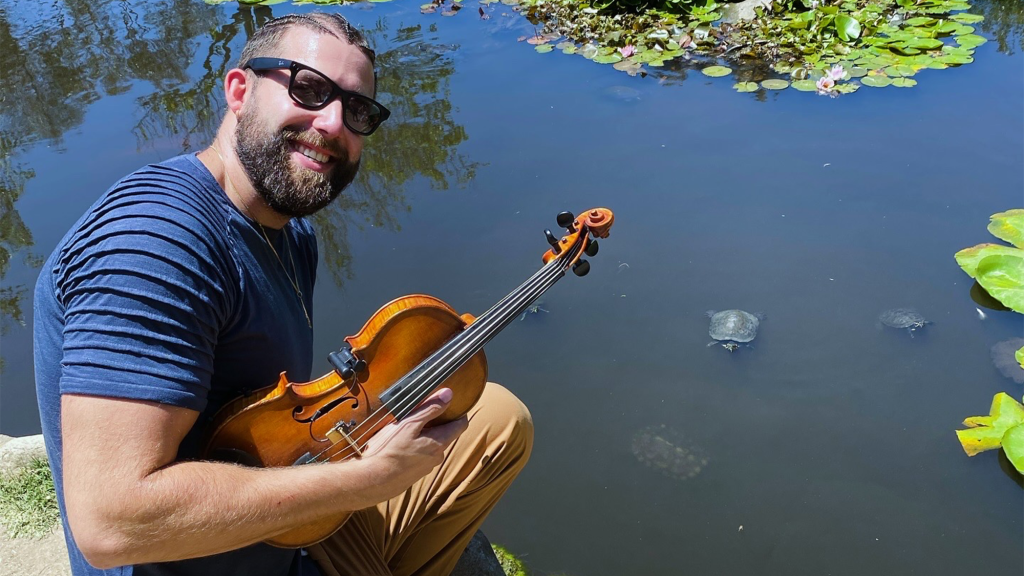Now Reading: The best ‘coffin roads’ to hike in Scotland this summer
-
01
The best ‘coffin roads’ to hike in Scotland this summer
The best ‘coffin roads’ to hike in Scotland this summer

Across abandoned expanses of Scotland’s wildest terrain, ancient footpaths chart a nearly forgotten history: Hundreds of mourners trudging from coasts and valleys, shouldering corpses in caskets for many miles. Over tall mountains, through rivers and woodlands, never letting the body touch the ground. Steeped in premonitions and superstition, these treks were a rural culture’s oldest death rites. Now, they’re some of the most unique hikes you can take.
Corpse, or coffin roads, were used throughout the Scottish Highlands and Islands to carry caskets on foot from the remotest places once populated by thousands, to cemeteries with burial rites. The Coffin Roads by Ian Bradley explains the centuries-old folk practices and lore associated with these well-trod trails in the West Highlands and Hebrides, which differentiate them from similar paths found throughout the United Kingdom.

A funeral in the Scottish Highlands. Illustration from the 19th century.
Photograph by clu, Getty Images
Bradley describes multi-day wakes turning “raucous and exuberant,” with whisky as an entire community prepared for a funeral procession of epic proportions. Groups of women skilled at keening crooned over the body, often following behind as the men set off, several at a time hoisting a heavy casket shoulder-high. They’d rest and change bearers often, propping the coffin on piles of stones called cairns, which can still be found in many uninhabited places.
Cairns were part of a series of rituals to prevent the dead from returning home, like traveling in winding routes to confuse the spirit, through water where it couldn’t follow; and the body’s feet pointed towards the burial site. These practices, Bradley says, initiated grieving in a community-led pilgrimage of gradual transition for both the living and the dead.
ScotWays, a charity maintaining Scotland’s rights of public access, details how to find several coffin roads in its guidebook, Scottish Hill Tracks. Volunteer director Tim Simons says it’s difficult to estimate how many existed. Separate from other paths traveled in daily life, used only to usher coffins, many are lost to living memory.
“Quite a few will have fallen out of use over 100 years ago,” Simons says, but those that remain, are an important part of the country’s cultural heritage, well worth exploring. “The more people travel [here],” he continues, “the busier it gets, but these routes are still relatively quiet. You can often do one and not see a single soul all day.”
Whether you’re undertaking a journey to commemorate a transition or just want to see some of Scotland’s most awe-inducing places, here are five coffin roads to explore.
(Hiking in the Scottish Highlands: Expert tips on five challenging routes to the peaks)
Best coffin road walks for beginners
One of Britain’s most important historic sites is a great starting point. Just over two hours from Glasgow, Kilmartin Glen holds more than 350 ancient relics like burial cairns, standing stones, and barrows—many prehistoric, constructed before England’s Stonehenge or Egypt’s earliest pyramids—all clustered in a six-mile stretch outside Kilmartin village.

Kilmartin Parish Church in Kilmartin Glen, Scotland.
Photograph by UK City Images, Alamy

The Kilmartin Stones are a collection of 79 ancient gravestones—one exception being a side-slab of a tomb chest—at Kilmartin Parish Church.
Photograph by Alba Tross, Alamy
Bradley describes this as the archetypal coffin road. “It’s clear from archaeological evidence that it was essentially a ritual landscape,” he explains. “There’s no evidence [of] people living there, it’s all monuments to the dead. Its prime purpose seems to have been as a kind of coffin road through which the dead would have been carried, with probably considerable ceremony, to various kinds of graves.” The easily accessible, roughly three-mile walk along flat paths winds through a linear cemetery, connecting some of the valley’s main sites.
(10 whimsical ways to experience Scotland)
The Green Isle Walk is also well-suited for beginners. It was one of several purported coffin roads crossing the West Highland Peninsulas to meet at a jetty on Loch Shiel; here, boats carrying caskets departed for St. Finan’s Isle, also called the Green Isle.
The Green Isle is a holy site dating to at least the seventh century that contains remains of a medieval chapel and a burial ground still in use. Just under three miles, out and back, the path follows Loch Shiel’s shoreline, through Scots pine, Atlantic oak, and green fields dotted with Cheviot sheep en route to the pier. Across the water, catch glimpses of stone crosses and tombstones silhouetted against the hills.
Intermediate island hikes
One of the most famous coffin roads is also one of the most frequented. The Isle of Harris was a substitute for planet Jupiter in the movie 2001: A Space Odyssey, and, more recently, the setting of Coffin Road, a crime novel by Peter May. The long reputed coffin route on the Isle of Harris in the Outer Hebrides crosses the island’s dramatic interior through the hill pass of Bealach Eòrabhat, headed for turquoise-edged white sand beaches, and cemeteries along the west coast. Over eight miles, lunar outcrops give way to moorlands and sweeping views of cliffs where golden eagles nest.

The Coffin Route on the Isle of Harris in the Outer Hebrides crosses the island’s dramatic interior toward the area’s white sand beaches.
Photograph by David Forster, Alamy
Craig McDonald, a trip leader with Wilderness Scotland, describes their most-requested coffin trek as a special one where cairns can still be seen. “It’s moderately difficult,” he explains, “but its trickiness doesn’t come so much from climbing, it’s more that there are a couple of sections up to the high point of Bealach Eòrabhat, where the path peters out, but there aren’t many other tracks that break off from it, so it’s difficult to take the wrong way.” Still, he recommends carrying a map and knowing how to use it. “If a fog or mist came in, it could get a bit disorienting.”
(8 activities to do under the stars in Scotland)
Challenging hiking trails in Scotland
For experienced hikers, some of the most remote trails can give the best sense of just how grueling these funeral processions were. McDonald describes the Applecross peninsula’s Kenmore to Applecross route as “a stunning walk with beautiful terrain.” It also features several old coffin cairns and historical features like stone markers and wrought iron gates.
(Why the Scottish Highlands is the best birdwatching destination in the UK)
The path’s destination would have likely been what is now Clachan Church, an early 19th-century building on the site of a seventh-century monastery. “It’s a challenging [hike],” McDonald says, “you’re in very remote country and people often do it as an out-and-back walk which is about [20 miles]. The track ascends about [1,640 feet] and it’s quite wet and boggy in places. There are a couple of river crossings as well, so if there’s been heavy rain in the days prior, I would err away from doing it unless you’re experienced or don’t mind getting your feet wet.”

The 11th-century Clachan Duich Church in Kintail National Scenic Area.
Photograph by Philip Sayer, Alamy
The coffin road to Kintail, one of the most storied paths, travels through its namesake, Kintail National Scenic Area. It’s one of several believed to have led over the Kintail mountains, which include multiple Munros (mountains in Scotland with an elevation greater than 3,000 feet), to Clachan Duich, an ancient burial ground sprawled around ruins of an 11th-century church at the head of a sea loch. Accounts of smugglers’ huts, 18th-century massacres, and mountaineer Frank Smythe’s well-documented paranormal visions along the route make it one of the most evocative.
Stretching 26 miles, from Glen Strathfarrar, it scales a high mountain pass and takes in the Falls of Glomach, one of Britain’s highest waterfalls. “It’s a very rugged landscape,” Bradley says. “You get a sense of the huge effort and hard work involved in carrying a heavy coffin over that terrain.”
(An eco-conscious adventure through the Scottish Highlands)
Andrea Bussell is a writer and ex-New Yorker living in the mountains of Scotland’s Highlands. Her writing about travel and culture is rooted in a love of nature, slow living, and indigenous wisdom of the places she visits. See more at @ambussell.























